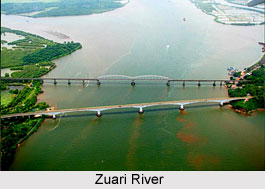 Zuari River is the largest river in the state of Goa, India. It is a tidal river. The river originates at Hemad-Barshem in the Western Ghats. The Zuari River is also referred to as the "Aghanashani" in the interior regions of Goa. Zuari is 92 km long, but is connected to other rivers and canals such as Mandovi River and Cumbarjuem Canal. The waters of the Mandovi and Zuari both flush out into the Arabian Sea at Cabo Aguada, a common point forming the Mormugao Harbour. Vasco Da Gama, the port city of Goa lies on the mouth of Zuari River.
Zuari River is the largest river in the state of Goa, India. It is a tidal river. The river originates at Hemad-Barshem in the Western Ghats. The Zuari River is also referred to as the "Aghanashani" in the interior regions of Goa. Zuari is 92 km long, but is connected to other rivers and canals such as Mandovi River and Cumbarjuem Canal. The waters of the Mandovi and Zuari both flush out into the Arabian Sea at Cabo Aguada, a common point forming the Mormugao Harbour. Vasco Da Gama, the port city of Goa lies on the mouth of Zuari River.
The Zuari along with the Mandovi River are the backbone of the economy and these along with their tributaries traverses a major portion of the state. The Zuari and Mandovi Rivers form an estuarine system. The banks of the Zuari River are covered with mangrove trees and are a perfect destination for adventure lovers. Crocodiles inhabit in the swampy and marshy area, which can be easily spotted while travelling in river cruises.
Course of Zuari River
The Zuari River flows in the south-western direction through the Quepem, Salcete, Ponda, Mormugao and Tiswadi taluks and finally evacuates into the Arabian Sea, around the Mormugao harbour. It merges with the Talaulim stream, at the town of Sanguem. It is in this town that the river widens and accepts waters from its tributary, Kushavati.
Zuari River Bridge
The famous Zuari Bridge built over the lengthy Zuari River connects North and South Goa and is the busiest bridge. The Zuari River also serves as a conduit for navigation of ore-laden ships into the hinterland.
Pollution in Zuari River
The ferrying of iron ore from Goa"s mining surroundings to the sea port by river for decades could be taking a toll on the health of two key rivers, the Mandovi and the Zuari.
A research report released recently by the Goa-based National Institute of Oceanography (NIO) reveals iron content in the Mandovi River and Zuari River and blames it on mining operations in the drainage basins of the water bodies as well as spillage from the transportation.
The river water have been polluted due to a high content of manganese, iron, cobalt and other trace elements leaching from iron ore dumps on their banks. The turbidity in the rivers influences the primary productivity and results in fish mortality or migration and siltation in channels.















